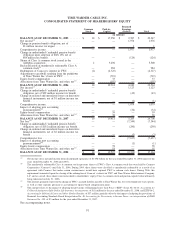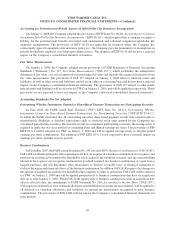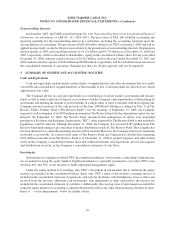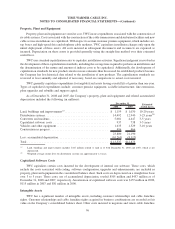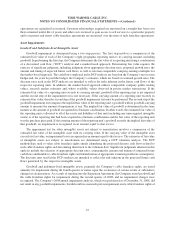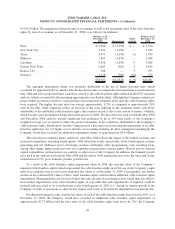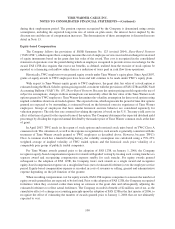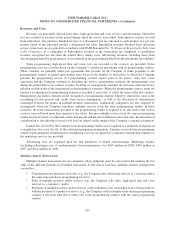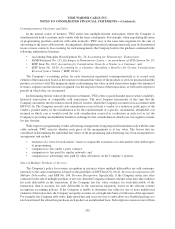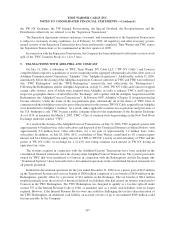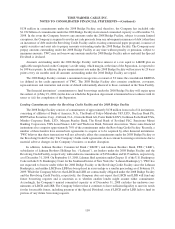Time Warner Cable 2008 Annual Report Download - page 111
Download and view the complete annual report
Please find page 111 of the 2008 Time Warner Cable annual report below. You can navigate through the pages in the report by either clicking on the pages listed below, or by using the keyword search tool below to find specific information within the annual report.Revenues and Costs
Revenues are principally derived from video, high-speed data and voice services and advertising. Subscriber
fees are recorded as revenues in the period during which the service is provided. Subscription revenues received
from subscribers who purchase bundled services at a discounted rate are allocated to each product in a pro-rata
manner based on the individual product’s determined fair value. Installation revenues obtained from subscriber
service connections are recognized in accordance with FASB Statement No. 51, Financial Reporting by Television
Cable Companies, as a component of Subscription revenues as the connections are completed, as installation
revenues recognized are less than the related direct selling costs. Advertising revenues, including those from
advertising purchased by programmers, are recognized in the period during which the advertisements are exhibited.
Video programming, high-speed data and voice costs are recorded as the services are provided. Video
programming costs are recorded based on the Company’s contractual agreements with its programming vendors.
These contracts are generally multi-year agreements that provide for the Company to make payments to the
programming vendors at agreed upon market rates based on the number of subscribers to which the Company
provides the programming service. If a programming contract expires prior to the parties’ entry into a new
agreement and the Company continues to distribute the service, management estimates the programming costs
during the period there is no contract in place. In doing so, management considers the previous contractual rates,
inflation and the status of the negotiations in determining its estimates. When the programming contract terms are
finalized, an adjustment to programming expense is recorded, if necessary, to reflect the terms of the new contract.
Management also makes estimates in the recognition of programming expense related to other items, such as the
accounting for free periods and credits from service interruptions, as well as the allocation of consideration
exchanged between the parties in multiple-element transactions. Additionally, judgments are also required by
management when the Company purchases multiple services from the same programming vendor. In these
scenarios, the total consideration provided to the programming vendor is required to be allocated to the various
services received based upon their respective fair values. Because multiple services from the same programming
vendor may be received over different contractual periods and may have different contractual rates, the allocation of
consideration to the individual services will have an impact on the timing of the Company’s expense recognition.
Launch fees received by the Company from programming vendors are recognized as a reduction of expense on
a straight-line basis over the life of the related programming arrangement. Amounts received from programming
vendors representing the reimbursement of marketing costs are recognized as a reduction of marketing expenses as
the marketing services are provided.
Advertising costs are expensed upon the first exhibition of related advertisements. Marketing expense
(including advertising), net of reimbursements from programmers, was $569 million in 2008, $499 million in
2007 and $414 million in 2006.
Multiple-element Transactions
Multiple-element transactions involve situations where judgment must be exercised in determining the fair
value of the different elements in a bundled transaction. As the term is used here, multiple-element arrangements
can involve:
• Contemporaneous purchases and sales (e.g., the Company sells advertising services to a customer and at
the same time purchases programming services);
• Sales of multiple products and/or services (e.g., the Company sells video, high-speed data and voice
services to a customer); and/or
• Purchases of multiple products and/or services, or the settlement of an outstanding item contemporaneous
with the purchase of a product or service (e.g., the Company settles a dispute on an existing programming
contract at the same time that it enters into a new programming contract with the same programming
vendor).
101
TIME WARNER CABLE INC.
NOTES TO CONSOLIDATED FINANCIAL STATEMENTS—(Continued)


